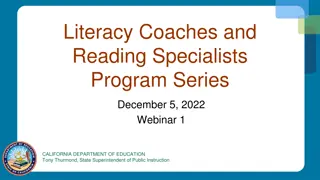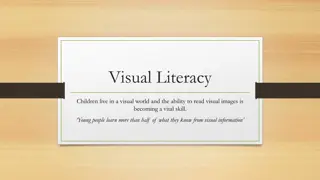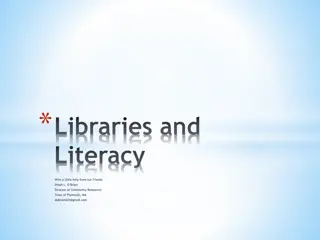Enhancing Early Literacy Skills through Learning Spaces and Activities
Explore Module 4 focusing on creating book-and-language rich learning environments for children to develop essential literacy skills. Discover strategies for modeling and practicing early language and literacy skills, and learn how to design learning spaces to promote conceptual knowledge. Aligns with the Read to be Ready Campaign, emphasizing the importance of early literacy. Dive into instructional presentations and application activities to enhance your understanding and application of these key concepts.
Download Presentation

Please find below an Image/Link to download the presentation.
The content on the website is provided AS IS for your information and personal use only. It may not be sold, licensed, or shared on other websites without obtaining consent from the author.If you encounter any issues during the download, it is possible that the publisher has removed the file from their server.
You are allowed to download the files provided on this website for personal or commercial use, subject to the condition that they are used lawfully. All files are the property of their respective owners.
The content on the website is provided AS IS for your information and personal use only. It may not be sold, licensed, or shared on other websites without obtaining consent from the author.
E N D
Presentation Transcript
Module 4 Learning Spaces & Activities Early Literacy Matters
Module 4: Learning Spaces & Activities Module 4 at a Glance In Module 3, you considered the important role teachers play in developing children s oral language and increasing their vocabulary. In this module, you will: Discover how to create book-and-language rich learning spaces that invite children to explore, inquire, create, problem-solve, and share learning. Explore the I do you watch, I do you help, You do I help, and You do I watch strategy for modeling and practicing early language and literacy skills. Gain a better understanding of how to use learning spaces and activities to provide increased opportunities for children to build conceptual knowledge. 2
Learner Outcomes for Module 4 Learner Outcomes: LO1: Learners will describe developmentally and age-appropriate learning spaces which are book- and-language rich learning spaces and invite children to explore, inquire, create, problem-solve, and share learning. LO2: Learners will explore the I do you watch, I do you help, You do I help, and You do I watch strategy for modeling and practicing early language and literacy skills. LO3: Learners will examine how to use learning spaces and activities to provide increased opportunities for children to build conceptual knowledge. 3
Connections to the Read to be Ready Campaign: This module aligns to the current Read to be Ready Campaign s following key beliefs: Early Literacy Matters: Teachers are critical: It takes a community: Video link to Early Literacy Matters from Read to be Ready Website: https://www.youtube.com/watch?v=60J8qRjRPkE 4
Module 4 Overview Overview: Module 4 will consist of 3 instructional presentations. These presentations will help you reflect on the special role a book-and-language rich classroom environment plays in providing opportunities for children to interact with and learn from one another, teachers, and materials. In Presentation 1, you will learn more about how to create book-and-language rich learning spaces that invite children to explore, inquire, create, problem-solve, and share what they learn. In addition, you will explore how learning is enhanced when books are included in all areas of the classroom. In Presentation 2, you will learn the benefits of using the I do, We do, and You do strategy for modeling and practicing early language and literacy skills. Emphasis is placed on scaffolding learning and providing opportunities for repeated practice. In Presentation 3, you will learn how to learning spaces and activities can be designed as opportunities to build conceptual knowledge. Following each presentation, you will apply your learning through Application Activities included in the Learning Guide. 5
Suggested Timeline for Completing Module Modules contain 4 short presentations that are designed to be completed during relaxed ratios or other times as set by your school or agency. Your director or program coordinator may suggest or establish a timeline for each presentation to be completed within the module. Please take a moment to confirm your site s requirements while noting the submission deadline for the final Learning Application Assignment that you will submit electronically to your literacy coach for feedback and support. All other completed activities will remain in your participation guide and available for your coaches review. Section 1: Start at beginning of module and complete Presentation 1 and Practice Activity 1. Section 2: Complete Presentation 2 and Practice Activity 2. Section 3: Complete Presentation 3 and Practice Activity 3. Section 4: Complete Learning Application Assignment for Module 4 and submit it electronically to your literacy coach for feedback and support. Please refer to your Learning Guide for a detailed Module 4 timeline and checklist. 6
Presentation 2: Introducing Learning Spaces In Presentation 1, you focused on types of learning spaces to include in the classroom to create book-and-language rich experiences for children. Once you have created learning spaces, you need to be intentional in how you introduce children to those spaces. In this Presentation, you will learn how to use the I do you watch, I do you help, You do I help, and You do I watch strategy to introduce learning spaces and centers. 7
I doyou watch, I doyou help, You doI help, and You doI watch Teacher-child interactions provide opportunities for teachers to scaffold learning. Lev Vygotsky (1978) coined the term scaffolding to describe the varying supports or scaffolds put in place to help children learn or reach a new level of learning. The I do-you watch, I do-you help, You do-I help and You do-I watch strategy begins with high levels of teacher support and modeling and gradually moves towards a low level of teacher support. 8
I doyou watch, I doyou help, You doI help, and You doI watch Let s look at the first two stages of I do you watch, I do you help, You do I help, and You do I watch strategy more closely. I do-you watch: Children learn through watching. Whether its talking, pouring cups, stacking blocks, or writing children intensely watch the teacher who models the skill. Words spoken and movements made should be slow and intentional. I do-you help: Teachers still are modeling the skill but invite the children to participate. When reading a story, a child may help by saying a repeated word or making an animal sound when appropriate. In dressing, a teacher may put on one sock and invite the child to help put the other sock on. In pouring, the teacher may pour most of the water into a cup and allow the child to help pour the rest. In stacking blocks, teacher can invite the child to place one or two of the blocks. In writing, the teacher may write the words on the paper and invite the child to add marks and pictures. In this stage, the teacher is still modeling and closely guiding. 9
I doyou watch, I doyou help, You doI help, and You doI watch Let s look at the last two stages of the I do you watch, I do you help, You do I help, and You do I watch strategy more closely. You do I help: Children complete the tasks with the teacher beside them ready to help as needed. Reminders and praises are given. You do I watch: This is the independent practice stage which allows children to complete tasks on own with teachers watching nearby ready to assist if needed. 10
Providing Literacy Scaffolds and Learning Supports Teachers promote children s learning and development by scaffolding; that is, they provide assistance and/or supports to enable each child to master a challenge just beyond his current level. The teacher gradually reduces this support as the child is able to proceed independently (Copple & Bredekamp, 2013, p. 154). 11
Providing Literacy Scaffolds and Learning Supports Scaffolding begins with a teacher taking time to really know the children. Teachers should talk often to children and interact with them warmly to build a trusting relationship with them. Children who feel safe and supported will show more interest in learning activities. Consider ways you can use the I do you watch, I do you help, You do I help, and You do I watch strategy for modeling and practicing early language and literacy skills. 12
Intentional Planning for Learning Centers Teachers intentionally plan their interactions with children during learning centers. Teachers play, especially when they can help children see expanded play possibilities. For example, some children may need adult help to play imaginatively, and caregivers can model for them, such as playing tea party (Copple & Bredekamp, 2013, p. 98). Teachers should consistently plan learning experiences that children are interested in and will find highly engaging. 13
Teachers play a critical role Teachers play a critical role in enriching language and literacy experiences as they interact with children in created learning spaces and centers. Just as we need to be intentional in our planning, we must be intentional in how we interact with children when they are engaged in learning centers. Plan daily for how you will model and provide children opportunities to make real-world connections with learning during center time. 14
Practice Activity 2: I do-you watch, I do-you help, You do-I help and You do-I watch with Dramatic Play For this practice activity, you will give the I do-you watch, I do-you help, you do-I help and you do-I watch strategy a try with your children around a dramatic play learning activity. For infants and young toddlers, finger puppets or mitts work great. They may not be able to do the activity on their own. Any interaction on their part counts and should be encouraged! Think of how you will set the activity up, model what will be done, and practice together with the child or children and let the child or children practice on their own during learning center time. After trying the I do-you watch, I do-you help, you do-I help and you do-I watch strategy with children during a dramatic play learning activity, proceed to the next part of Practice Activity 2 to reflect on the learning experience. 15
Reflection Questions for Practice Activity 2 Reflect on the I do-you watch, I do-you help, you do-I help and you do-I watch dramatic play activity you engaged a children or a small group of children in and briefly respond to each of the questions below in the Learning Guide: How was planning ahead helpful? How was modeling the activity for children helpful? How was doing the activity with children helpful? How did children respond when it was their turn with the activity? How did your interactions help to foster children s engagement with the dramatic play materials? 16
End of Section 2 Congratulations, you just completed Section 2 of Module 4. Be sure you have completed Section 2 activities in the Learning Guide. When ready, move on to the presentation for Section 3. 17























